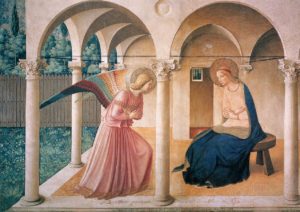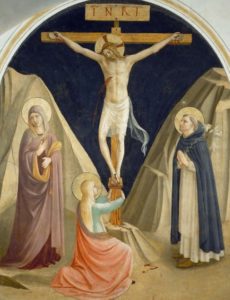Originally known in the Roman Missal as the celebration of Our Lady of Compassion, the feast of Our Lady of Sorrows has been commemorated in the Church since the 15th century. The Seven Sorrows of Mary focus mainly on the Passion of Our Lord. I would like to suggest that there is a wider understanding today of the totality of her experience of the human condition and that Mary is a paradigm for all of us who have our own Via Dolorosa to walk.
 Mary could be called a woman for all seasons of life since there is scarcely a human dilemma that she did not know. From early in life, she was presented with incredibly difficult decisions that one could only describe as being caught between a rock and a hard place. The gospels share with us several insights into her early life and the challenges that she had to face. One of the first disconcerting events was the Annunciation (Luke 1). The famous Early Renaissance fresco by Fra Angelico in the Convent of San Marco, Florence, is extraordinarily beautiful but does not depict for us the weight or pressure that she would endure because of her “Yes” to God’s invitation to life.
Mary could be called a woman for all seasons of life since there is scarcely a human dilemma that she did not know. From early in life, she was presented with incredibly difficult decisions that one could only describe as being caught between a rock and a hard place. The gospels share with us several insights into her early life and the challenges that she had to face. One of the first disconcerting events was the Annunciation (Luke 1). The famous Early Renaissance fresco by Fra Angelico in the Convent of San Marco, Florence, is extraordinarily beautiful but does not depict for us the weight or pressure that she would endure because of her “Yes” to God’s invitation to life.
One can imagine what must have gone through her mind. How would Joseph react? Would he divorce her as the Law prescribed? How would her parents and friends deal with this? We all know how small towns deal with apparent scandals. The gossip mongers would have a field day with this news. She could face total abandonment by the very people on whom she depended. Perhaps the most hurtful was the potential to lose her betrothed, Joseph.
Today we know only too well the stress and heartbreak that is involved in situations of separation and divorce for those who have endured such painful rifts. We have seen this within our own families.
After Mary and Joseph are amazingly able to work through this predicament, they are required to travel to the birthplace of Joseph to register for the Roman census. While journeying, Mary gives birth to her son in the terrible conditions of a stable or cave filled with animals.
Today women in war-torn countries are forced to care for their babies surrounded by poverty and the lack of adequate shelter, water, and food for their families.
Following the birth of her child, Mary, Joseph, and Jesus became fugitives and were forced to flee into exile where they remained for several years amidst a very different culture.
As streams of migrants come to our shores and are not always welcomed, they too share this dilemma with the Holy Family. Certainly, the Mother of Sorrows could commiserate with these desperate people. Pope Francis has recently given Mary the title “Solace of Migrants.”
As the time for Jesus’ public ministry arrived, Mary had to take leave of her beloved son. How difficult it is for any parent today to watch a child leave the nest, most likely never to return—especially if the road her child has chosen is one fraught with dangers and hardships. Can you imagine the anxiety she must have suffered when even his own village of Nazareth turned against him as he preached in their own synagogue? Likely, Mary was present as they tried to attack him and throw him out of the very village where he had grown up.
She well understood the pain and anxiety of being the mother of a marked man, as some mothers of gay or transexual children encounter today. How wonderful it is to know that we have a mother to reach out to when our suffering becomes intolerable.
 And finally, what can we possibly say about the agony of watching one’s child endure the ignominious death of crucifixion? There is no grief like the loss of a child but under such conditions as these!
And finally, what can we possibly say about the agony of watching one’s child endure the ignominious death of crucifixion? There is no grief like the loss of a child but under such conditions as these!
A very good friend of mine just lost her 51-year-old son. Understandably she was devastated and all I could do was listen since one would have to have had that experience to comprehend fully such a loss. What about all the mothers today who have lost children due to racial violence, war, and school murders? Mary weeps with them as well.
We have a very beautiful hymn that is sung every Lent during the Stations of the Cross called the Stabat Mater Dolorosa. The words inspire us to be faithful to Christ as Mary was—regardless of what we are called to bear.
Let us for a moment ponder the words of the Stabat Mater and ask our beloved Mother Mary to give us the strength to bear our sorrows as she did.
At the cross her station keeping,
Stood the mournful mother weeping,
Close to Jesus to the last.
Through her heart, his sorrow sharing,
All his bitter anguish bearing,
Now at length, the sword has passed.
Is there one who would not weep,
Whelmed in misery so deep,
Of her dying glorious Son.
Let me mingle tears with thee
Mourning him who mourned for me
All the days that I may live.
As Mary stood unwavering at the foot of the Cross, Jesus gave her to us knowing what a courageous example she could be for us. She still stands with us today in all our tribulations under our own crosses.
Let us always remember that, as we pray in the Hail Mary, she is with us now and at the hour of our death.
 – Sister Helen R. Boyd, OP
– Sister Helen R. Boyd, OP
Sister Helen resides in Dominican Convent where she serves on the Life Enrichment Committee and co-chairs the Committee for Serving Vulnerable Populations.
Graphics: The Annunciation and Crucifixion with The Virgin, Mary Magdalene and St. Dominic by Fra Angelico (Convento di San Marco, Florence, Italy)
